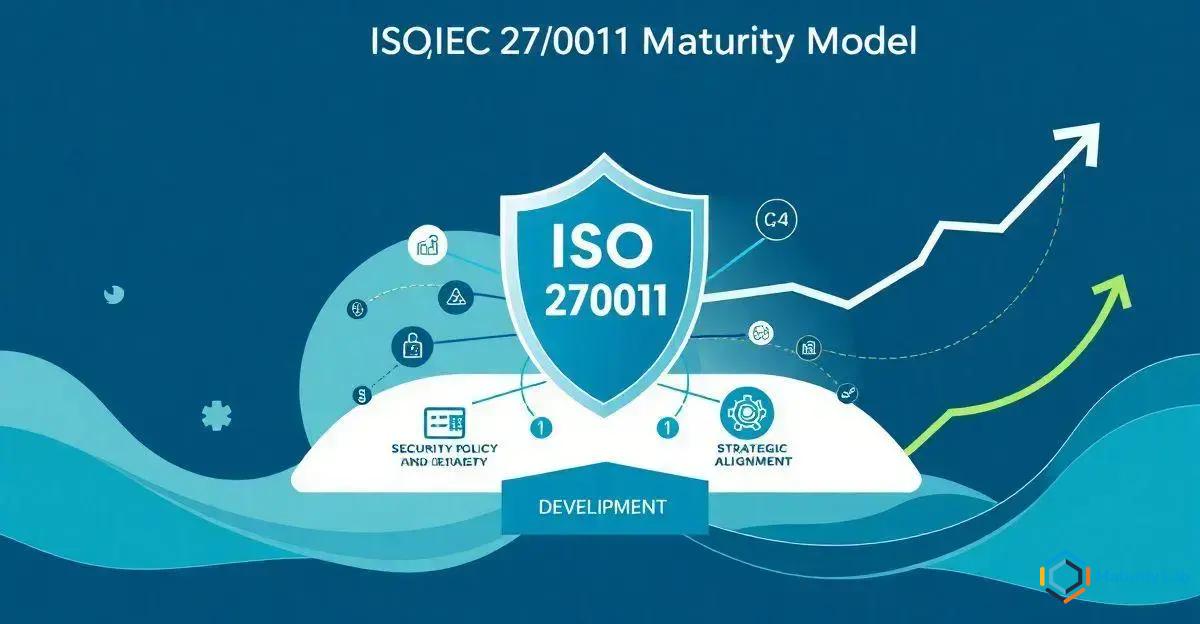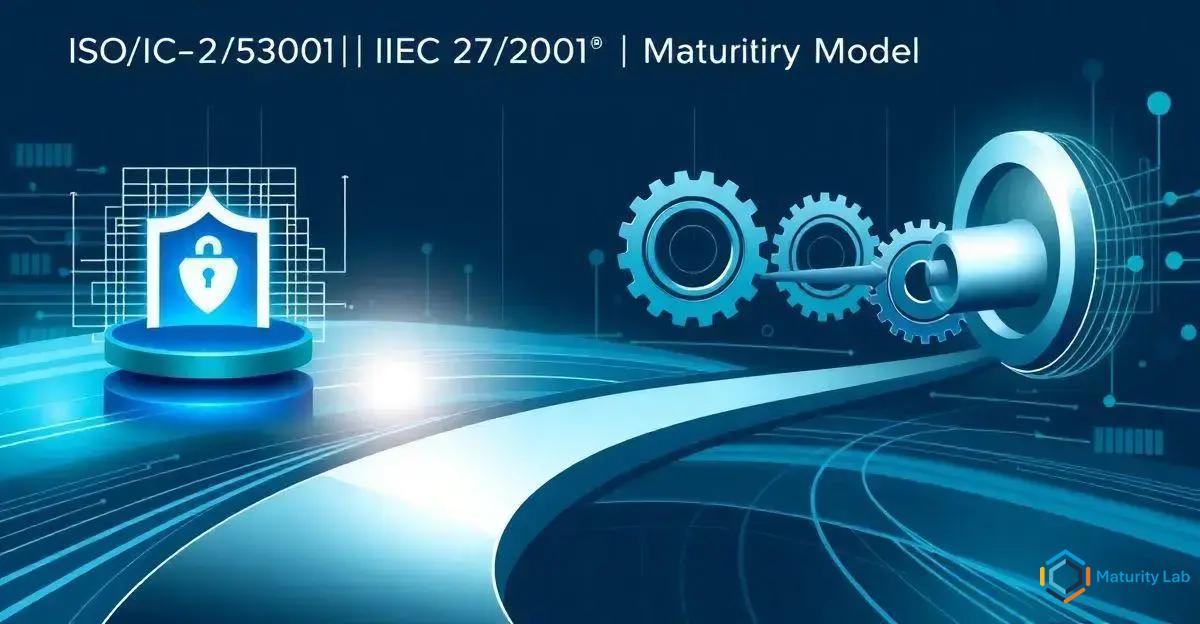The ISO/IEC 27001 Maturity Model offers a comprehensive framework for organizations to enhance their information security management systems (ISMS). By implementing this model, businesses can systematically improve their security practices, conduct risk assessments, define security objectives, and establish incident response plans, all while ensuring compliance with international standards. This strategic alignment with ISO/IEC 27001 not only supports broader business goals but also maximizes the value of security investments, fostering a resilient organization adept at navigating the complexities of the digital landscape.
In today’s rapidly evolving digital landscape, the importance of a robust security framework cannot be overstated. The ISO/IEC 27001 Maturity Model offers a structured approach to enhancing your organization’s security policy and achieving strategic alignment. By understanding and implementing this model, businesses can ensure their information security management systems (ISMS) are both effective and compliant with international standards. This article delves into the intricacies of the ISO/IEC 27001 Maturity Model, providing insights into developing a comprehensive security policy and aligning it with your strategic objectives.
Understanding the ISO/IEC 27001 Maturity Model

The ISO/IEC 27001 Maturity Model is a framework designed to help organizations assess and enhance their information security management systems (ISMS). This model provides a structured approach to evaluating the current state of an organization’s security practices and identifying areas for improvement. By following the maturity model, businesses can systematically progress through different levels of maturity, ultimately achieving a robust and compliant ISMS.
The maturity model is typically divided into several levels, each representing a different stage of development and capability. These levels often include Initial, Managed, Defined, Quantitatively Managed, and Optimizing. At the Initial level, security practices are usually ad hoc and reactive, with little to no formal processes in place. As organizations move to the Managed and Defined levels, they begin to establish and document security policies and procedures, ensuring a more consistent and proactive approach to information security.
Benefits of the Maturity Model
One of the key benefits of the ISO/IEC 27001 Maturity Model is its ability to provide a clear roadmap for improvement. By assessing their current maturity level, organizations can identify specific actions needed to advance to the next level. This can include implementing new security controls, enhancing existing policies, or investing in employee training and awareness programs. Additionally, the maturity model helps organizations align their security efforts with business objectives, ensuring that security initiatives support overall strategic goals.
For example, an organization at the Managed level might focus on developing a comprehensive risk management process, while a company at the Defined level could work on integrating security practices into their overall business processes. By continuously improving their ISMS, organizations can not only achieve compliance with ISO/IEC 27001 standards but also enhance their overall security posture, reducing the risk of data breaches and other security incidents.
Wouldn’t it be more efficient to implement an action plan to enhance your company’s maturity after understanding its current maturity level? By leveraging the ISO/IEC 27001 Maturity Model, organizations can take a systematic and strategic approach to information security, ensuring that their ISMS is both effective and aligned with business objectives.
Developing a Robust Security Policy

Developing a robust security policy is a critical component of any effective information security management system (ISMS). A well-crafted security policy not only sets the foundation for protecting sensitive information but also provides clear guidelines for employees and stakeholders on how to handle data securely. The ISO/IEC 27001 standard offers a comprehensive framework for creating and maintaining a security policy that aligns with international best practices.
The first step in developing a robust security policy is to conduct a thorough risk assessment. This involves identifying potential threats and vulnerabilities that could impact the organization’s information assets. By understanding the specific risks your organization faces, you can tailor your security policy to address these challenges effectively. The risk assessment should be a continuous process, with regular reviews and updates to ensure that the policy remains relevant in the face of evolving threats.
Once the risks have been identified, the next step is to define the security objectives and scope of the policy. This includes specifying the information assets that need protection, the security controls that will be implemented, and the roles and responsibilities of employees in maintaining security. Clear and concise documentation is essential, as it ensures that everyone in the organization understands their obligations and the measures in place to protect information.
An effective security policy should also include procedures for incident response and recovery.
This ensures that the organization is prepared to handle security breaches or other incidents promptly and effectively. By having a well-defined incident response plan, organizations can minimize the impact of security incidents and quickly restore normal operations. Additionally, regular training and awareness programs are crucial for ensuring that employees are knowledgeable about the security policy and their role in maintaining it.
For example, a company might implement a policy that requires all employees to use strong, unique passwords and to change them regularly. The policy could also mandate the use of multi-factor authentication for accessing sensitive systems and data. By enforcing these measures, the organization can significantly reduce the risk of unauthorized access and data breaches.
Wouldn’t it be prudent to periodically review and update your security policy to ensure it remains effective? By following the ISO/IEC 27001 framework, organizations can develop a robust security policy that not only meets compliance requirements but also enhances their overall security posture, protecting their valuable information assets from potential threats.
Achieving Strategic Alignment with ISO/IEC 27001

Achieving strategic alignment with ISO/IEC 27001 involves ensuring that your information security management system (ISMS) supports and enhances your organization’s overall business objectives. This alignment is crucial for maximizing the value of your security investments and ensuring that security initiatives contribute to the broader goals of the organization. By aligning your ISMS with your strategic objectives, you can create a more cohesive and effective approach to information security.
The first step in achieving strategic alignment is to understand your organization’s business objectives and how information security can support these goals. This requires close collaboration between the security team and other business units to identify key priorities and areas where security can add value. For example, if one of your organization’s strategic objectives is to expand into new markets, your ISMS should include measures to protect sensitive customer data and comply with international data protection regulations.
Integrating Business Objectives into ISMS
Once the business objectives are clear, the next step is to integrate these objectives into your ISMS. This involves aligning your security policies, procedures, and controls with the strategic goals of the organization. For instance, if improving customer trust is a key objective, your ISMS should include robust data protection measures and transparent communication practices to demonstrate your commitment to security. By embedding security into the fabric of your business processes, you can ensure that security initiatives are not seen as separate or siloed but as integral to achieving business success.
Another important aspect of strategic alignment is performance measurement. This involves setting key performance indicators (KPIs) and metrics to track the effectiveness of your ISMS in supporting business objectives. Regularly reviewing these metrics allows you to identify areas for improvement and make data-driven decisions to enhance your security posture. For example, you might track the number of security incidents, the time taken to respond to incidents, and the level of employee compliance with security policies. By continuously monitoring and improving your ISMS, you can ensure that it remains aligned with your strategic goals.
Wouldn’t it be beneficial to have a clear roadmap for aligning your security efforts with your business objectives? By leveraging the ISO/IEC 27001 framework, organizations can achieve strategic alignment, ensuring that their ISMS not only meets compliance requirements but also drives business success. This holistic approach to information security helps build a resilient organization capable of navigating the complexities of the digital landscape.
In conclusion, the ISO/IEC 27001 Maturity Model serves as an invaluable tool for organizations aiming to enhance their information security management systems (ISMS). By understanding the various levels of maturity, businesses can systematically improve their security practices, ensuring they are both effective and compliant with international standards.
Developing a robust security policy is a fundamental step in this process, providing clear guidelines and procedures to protect sensitive information and respond to incidents efficiently.
Strategic Alignment
Moreover, achieving strategic alignment with ISO/IEC 27001 ensures that your security initiatives support and enhance your organization’s broader business objectives. This alignment not only maximizes the value of your security investments but also fosters a cohesive approach to information security that is integral to business success.
By continuously assessing risks, updating security policies, and measuring performance, organizations can maintain a resilient ISMS that adapts to evolving threats and business needs.
Wouldn’t it be more efficient to implement an action plan to enhance your company’s maturity after understanding its current maturity level? By leveraging the ISO/IEC 27001 framework, organizations can take a systematic and strategic approach to information security, ensuring that their ISMS is both effective and aligned with business objectives.
This holistic approach helps build a resilient organization capable of navigating the complexities of the digital landscape, ultimately protecting valuable information assets and supporting long-term success.
Frequently Asked Questions about ISO/IEC 27001 Maturity Model, Security Policy, and Strategic Alignment
What is the ISO/IEC 27001 Maturity Model?
The ISO/IEC 27001 Maturity Model is a framework designed to help organizations assess and enhance their information security management systems (ISMS). It provides a structured approach to evaluating current security practices and identifying areas for improvement.
How can the ISO/IEC 27001 Maturity Model benefit my organization?
By following the ISO/IEC 27001 Maturity Model, organizations can systematically improve their security practices, ensuring they are both effective and compliant with international standards. This leads to a more robust and resilient ISMS.
What are the key steps in developing a robust security policy?
Key steps include conducting a thorough risk assessment, defining security objectives and scope, documenting policies and procedures, and establishing incident response and recovery plans. Regular training and awareness programs are also crucial.
Why is strategic alignment important in information security?
Strategic alignment ensures that information security initiatives support and enhance the organization’s broader business objectives. This maximizes the value of security investments and fosters a cohesive approach to information security.
How can I achieve strategic alignment with ISO/IEC 27001?
Achieving strategic alignment involves understanding your business objectives, integrating these objectives into your ISMS, and setting key performance indicators (KPIs) to track effectiveness. Regularly reviewing and updating your ISMS ensures it remains aligned with strategic goals.
What are the benefits of regularly updating my security policy?
Regularly updating your security policy ensures it remains relevant in the face of evolving threats. This helps maintain a robust security posture, reduces the risk of data breaches, and ensures compliance with current standards and regulations.

